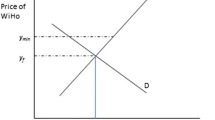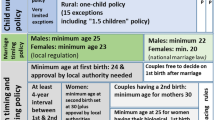Abstract
Whether common law marriage (CLM) in the US affects teen birth rates is the central question we address. CLM effects were identified through cross-state and time variation, as four states repealed the law over the period of study. Using microdata from Current Population Survey Fertility supplements 1990–2010 and state-level data from CDC Vital Statistics 1988–2012 we found that, in the states where CLM was first available but then repealed, the odds that teens would become new mothers increased. Births to teens younger than 18 were more responsive to availability of CLM than those to teens aged 18 or 19 or to women in their early twenties. The likelihood of becoming a mother increased where CLM was available in the years prior to its repeal. Teens were more responsive to information about availability of CLM about three years later than to knowing that it is available at the time of potential conception. To the extent that they reduce teen births CLM laws are socially desirable and states that still have CLM may be better off by not repealing the law.



Similar content being viewed by others
Notes
In Nebraska the legal age of marriage is 19. All states require parental consent for minors age 16–18 and minors age 14–15 require permission from Juvenile Court. See http://www.usmarriagelaws.com/search/united_states/teen_marriage_laws/.
Another law that could affect fertility via its effect on men’s willingness to cohabit or marry is a law establishing unilateral divorce. Such law is likely to increase a single man’s willingness to marry his unborn child’s mother. In turn, a higher likelihood of marriage will make it more likely that a woman will choose marital fertility rather than its alternatives (no birth or non-marital fertility). This helps explain the finding that unilateral divorce laws led to a drop in the ratio of non-marital to marital births in the US (Drewianka 2008) and Europe (Bellido and Marcen 2014). Drewianka’s explanation for this finding was similar: unilateral divorce leads to lower costs of entering marriage. All states except New York adopted unilateral divorce by 1990. Excluding NY does not substantially alter our results.
Teen fertility rates for age group 15–17 are calculated by the authors.
We have also tried including the following control variables: shares of black and Hispanic population, housing price index, the fraction of State House that is Democrat, and the number of male prisoners per 100,000 male population. None of these variables had a strong effect on the probability that the adolescent has a child.
IPUMS-CPS, University of Minnesota, http://www.ipums.org.
References
Becker, G. S. (1960). An economic analysis of fertility. In Demographic and economic change in developed countries, a Conference of the Universities–National Bureau Committee for Economic Research. Princeton, N.J.: Princeton University Press.
Bellido, H. & Marcen, M. (2014). Divorce laws and fertility. Labour Economics, 27, 56–70. doi:10.1016/j.labeco.2014.01.005.
Bertrand, M., Duflo, E., & Mullainathan, S. (2004). How much should we trust difference-in-difference estimates? The Quarterly Journal of Economics, 119, 249–275. doi:10.1162/003355304772839588.
Dettling, L., & Kearney, M. (2014). House prices and birth rates: the impact of the real estate market on the decision to have a baby. Journal of Public Economics, 110, 82–100. doi:10.1016/j.jpubeco.2013.09.009.
Drewianka, S. (2008). Divorce law and family formation. Journal of Population Economics, 21, 485–503. doi:10.1007/s00148-006-0119-2.
Ekert-Jaffe, O., & Grossbard, S. (2008). Does community property discourage unpartnered births? European Journal of Political Economy, 24, 25–40. doi:10.1016/j.ejpoleco.2007.06.006.
Fernández, R., & Fogli, A. (2009). Culture: An empirical investigation of beliefs, work, and fertility. American Economic Journal: Macroeconomics, 1(146 –), 77. doi:10.1257/mac.1.1.146.
Grossbard, S. (2015). The marriage motive: aA price theory of marriage; how marriage markets affect employment, consumption, and savings. New York: Springer. ISBN 978-1-4614-1623-4.
Grossbard, S. & Vernon, V. (2014). Common law marriage and couple formation. IZA Journal of Labor Economics, 3, 16. doi:10.1186/s40172-014-0016-y.
Grossbard, S., & Vernon, V. (2015). Convergence in male–female labor supply and common law marriage, Research in Labor Economics. Volume on Gender Convergence in the Labor Market, 41, 143–175. doi:10.1108/S0147-912120140000041012.
Hamilton, B. E., Martin, J. A., Osterman, M. J. K., & Curtin, S. C. (2014). Births: Preliminary data for 2013. Hyattsville, MD: National Center for Health Statistics. Retrieved from http://www.cdc.gov/nchs/data/nvsr/nvsr63/nvsr63_02.pdf.
Hoffman, S. D. & Maynard, R. A. (Eds.). (2008). Kids having kids: economic costs and social consequences of teen pregnancy (2nd ed.) Washington, DC: Urban Institute Press. Retrieved from http://works.bepress.com/rebecca_maynard/6/.
Kearney, M., & Levine, P. B. (2015). Investigating recent trends in the U.S. teen birth rate. Journal of Health Economics, 41, 15–29. doi:10.1016/j.jhealeco.2015.01.003.
Levine, P. B., Staiger, D., Kane, T. J., & Zimmerman, D. J. (1999). Roe v. Wade and American fertility. American Journal of Public Health, 89, 199–203. doi:10.2105/AJPH.89.2.199.
Lind, G. (2008). Common law marriage: A legal institution for cohabitation. New York: Oxford University Press. doi:10.1093/acprof:oso/9780195366815.001.0001.
Martin, J. A., Hamilton, B. E., & Osterman, M. J. K. (2014). Births in the United States, 2013. NCHS Data Brief No. 175, December. Hyattsville, MD. Retrieved from http://www.cdc.gov/nchs/data/databriefs/db175.htm.
Martinez, G., Copen, C. E., & Abma, J. C. (2011). Teenagers in the United States: Sexual activity, contraceptive use, and childbearing, 2006–2010 National Survey of Family Growth. Washington, DC: National Center for Health Statistics. Retrieved from http://www.cdc.gov/nchs/data/series/sr_23/sr23_031.pdf.
Mechoulan, S. (2011). The external effects of black male incarceration on black females. Journal of Labor Economics, 29, 1–35. doi:10.1086/656370.
Mincer, J. (1963). Market prices, opportunity costs, and income effects. In C. Christ (Ed.), Measurement in economics. Stanford, CA: Stanford University Press.
Mincy, R., Grossbard, S. & Huang, C. (2005). An economic analysis of co-parenting choices: single parent, visiting father, cohabitation, marriage. EconWPA papers in Labor and Demography #0505004, May. Retrieved from https://www.researchgate.net/publication/23746785_An_Economic_Analysis_of_Co-Parenting_Choices_Single_Parent_Visiting_Father_Cohabitation_Marriage.
Moore, K., Sacks, V., Manlove, J., & Sawhill, I. (2014). What if you earned a diploma and delayed parenthood? Bethesda, MD: Child Trends. Retrieved from http://www.childtrends.org/wp-content/uploads/2014/12/2014-27SocialGenomeDelayChildbearing.pdf.
Moulton, B. (1990). An illustration of a pitfall in estimating the effects of aggregate variables on micro units. The Review of Economics and Statistics, 72, 334–338. doi:10.2307/2109724.
Stevenson, B. (2007). The impact of divorce laws on marriage: specific capital. Journal of Labor Economics, 25, 75–94. doi:10.1086/508732.
United Nations (2013). 2012 Demographic yearbook. New York, New York. Retrieved from http://unstats.un.org/unsd/demographic/products/dyb/dybsets/2012.pdf.
Vespa, J., Lewis, J. M. & Kreider, R.M. (2013). America’s families and living arrangements 2012. Retrieved from http://www.census.gov/prod/2013pubs/p20-570.pdf.
Acknowledgements
We thank the editor, anonymous referees and participants in the Demography seminar at the University of Chicago (especially Ioana Marinescu and Ofer Malamud) and in the IZA SOLE Transatlantic Meetings (especially David Neumark) for valuable comments.
Author information
Authors and Affiliations
Corresponding author
Appendix
Rights and permissions
About this article
Cite this article
Grossbard, S., Vernon, V. Common Law Marriage and Teen Births. J Fam Econ Iss 38, 129–145 (2017). https://doi.org/10.1007/s10834-016-9511-6
Published:
Issue Date:
DOI: https://doi.org/10.1007/s10834-016-9511-6




